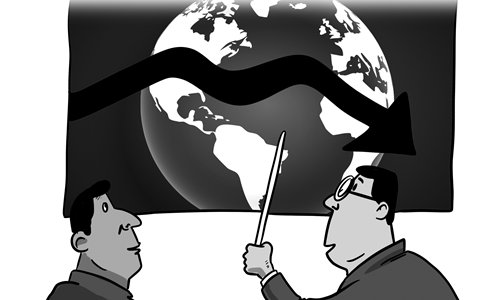HOME >> BUSINESS
Economies of Europe, US, Japan all have one drawback China can learn from
By Cao Heping Source:Global Times Published: 2019/11/11 20:23:40

Illustration: Luo Xuan/GT
Robert Shiller, Nobel Laureate in economics, once summarized that there are obvious defects in the system construction of the macroeconomic theory which guides today's world economic development. These drawbacks of macroeconomics have encountered great challenges in the past few years. Judgement made based on existing macroeconomic theory have often turned out to be inaccurate.There is a theory in macroeconomics called the Phillips curve: The ideal targets of inflation and employment could not be achieved at the same time.
With the help of loose monetary policy or the corresponding policy combination, the unemployment rate can be lowered and economic upturn can be realized, but inflation often rises during the process. However, in the past 10 years, it has seemed that with the "seesaw effect" of the Phillips curve concerning the relationship between inflation and unemployment, economic growth has disappeared.
Although the US has been trying to recover since the 2008 financial crisis, the economy is still operating at a low level. But American employment has been improving.
In some European countries and other countries such as Japan, which have different economic compositions, economic development stages, resource endowments and economic growth models, this phenomenon that is contrary to mature macroeconomic theory has also appeared.
How has this paradox come about? The common factor behind these incidences is that over the past 40 years, the computer and internet economy that replaced mental labor by humans, particularly digital technology, multi-dimensional digital terminals and internet sharing technologies, have caused the US economy and, in fact, the economic structures of many countries in the world to transform.
Under the new technical conditions, employment elasticity corresponding to primary, secondary and tertiary industries is much higher than it was in the past.
The failure of some macroeconomic theories represented by the Phillips curve has become a universal phenomenon. The adjustment of macro policies globally has had an effect. That is, such policies fail to adapt to changes in economic structure brought about by technological change over time.
The first example is the so-called "lost 20 years" that began in Japan in the mid-1990s.
Stagnation occurred for many reasons. Japan's industrial strategy at that time was wrong and missed the opportunities of the digital technology era. The country's aging population and declining birthrate were serious and domestic demand was insufficient. Its business environment and policies lost competitiveness with other economies which were more "business oriented."
The second example is Europe's 15-year-long economic downturn that started at the beginning of the 21st century. It seems to have been caused by Europe's own problems on the surface, but in actuality, the EU made the same mistake as Japan, at least from the perspective of monetary policy adopted when rescuing Portugal, Italy, Greece, and Spain.
If the EU does not change its laissez faire management of neoliberalism and undertake the two tasks to prevent inflation and promote factor circulation and full employment, Europe is likely to follow in Japan's path.
The third example is the US, which has been pursuing a strong recovery. Some economists believe that the US economic cycle is about 5.2 years long, and the financial crisis in 2008 may make this cycle's downturn longer.
It is true that the US economy has been bouncing up and down. From the administration of former US president Barack Obama to the current administration of President Donald Trump, US financial and monetary policymakers have also been practitioners of neoliberal economics.
If the current economic reality supported by digital technology is in an inferior position to overly cautious economic stimulus policies, the US economy may suffer a longer period of low growth or even stagnation.
Over the past 40 years, the macroeconomic management teams of all countries in the world have been affected to varying degrees by new mainstream economics and monetary-policy ideas that have been fully-developed since the 1980s.
Macroeconomic structure has undergone tremendous changes due to technological development. Now, when policymakers need new theories and policies to guide them, they tend to follow the old policy mix because theory always lags behind practice, and they end up with bitter results.
The mistakes that Europe, the US, and Japan have made are good lessons for China. The country needs to study new macroeconomic theories based on the general trends of the world economy and its own economic reality in order to adapt to the new economic structure and reality.
China's macroeconomic researchers and policymakers today should learn from the reform pioneers of 1978 or 1993, boldly launching fiscal and monetary theories and policies suitable for China's economic development, helping solve problems in the current economy and directing the economy toward a healthier development path.
The author is a professor at the School of Economics at Peking University in Beijing. bizopinion@globaltimes.com.cn
Posted in: EXPERT ASSESSMENT